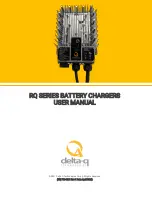
3
Due to the phenomena of gas recombination a difference of ± 2% (earlier in
float life ± 5% is common) for an individual cell voltage can be observed.
However the total voltage of the battery shall be within the limits stated
above.
Charging Current
Utilising a constant voltage charger results in a charging current that is self
limiting.
Fast Recharge
Occasionally (4 or 5 times a year) the battery may be recharged at 2.40Vpc
with a current limit of 0.1C10A. Fast charging should be stopped after
approximately 10 or 15 hours.
Ripple Current
Unacceptable levels of ripple current from the charger or the load can cause
permanent damage and a reduction in service life. It is recommended to
limit the continuous ripple current to 0.05C10A.
State of Charge
The battery state of charge can be determined approximately by measuring
the open circuit voltage after the battery has been at rest for a minimum of
24 hours at 25°C.
DISCHARGING
End of Discharge Voltage
The end of discharge voltage must be limited to 1.60Vpc.
A protecting system shall have to be installed to prevent deep discharge.
Discharged Cells/Monoblocs
DataSafe
®
HX+/HX batteries must not be left in a discharged condition after
supplying the load, but must be immediately returned to float recharge
mode. Failure to observe these conditions may result in greatly reduced
service life and unreliability.
Accidental Deep Discharge
When the battery is completely discharged, the sulphuric acid is completely
absorbed and the remaining electrolyte consists only of water. At this point,
the sulphation of the plates is at its maximum, considerably increasing the
cell’s internal resistance.
Important notice: this type of deep discharge will provoke a premature
deterioration of the battery and a noticeable effect on life expectancy.
Effect of temperature on capacity
Correction factor of the capacity, according to temperature.
MAINTENANCE/CHECKS
DataSafe HX+/HX batteries are maintenance free, sealed, lead acid batteries
and need no water addition.
Warning:
The cases and lids shall be kept dry and free from dust. Cleaning
must be done only with a damp cotton cloth. Do NOT use any type of oil,
solvent, detergent, petroleum-based solvent or ammonia solution to clean
the battery containers or lids. These materials will cause permanent
damage to the battery container and lid and will invalidate the warranty.
Check monthly that the total voltage at battery terminals is (N x 2.24 to 2.27
V) for a temperature of 25°C (N being the number of cells in the battery).
Every 12 months, read and record the following:
• Individual cell or unit voltages (volts)
• Cell-to-cell connection resistance (ohms)
• Terminal connection resistance (ohms)
• Ambient temperature in the immediate battery environment
Keep a logbook to record values, power outages, discharge tests, etc.
An autonomy check can be carried out once or twice a year.
The above record taking is the absolute minimum to protect the warranty.
This data will be required for any warranty claim made on the battery.
5°C 0.84
10°C 0.88
15°C
0.93
20°C 0.97
25°C
1.00
30°C 1.03
35°C 1.05
40°C 1.07
Temperature
Correction Factor
State of charge
Voltage
100%
2.12 to 2.14 V/Cell
80%
2.09 to 2.11 V/Cell
60%
2.05 to 2.08 V/Cell
40%
2.01 to 2.04 V/Cell
20%
1.97 to 2.00 V/Cell
0°C
2.33 to 2.36 Vpc
10°C
2.30 to 2.33 Vpc
20°C
2.27 to 2.30 Vpc
25°C
(reference temperature)
2.24 to 2.27 Vpc
30°C
2.23 to 2.26 Vpc
35°C
2.21 to 2.24 Vpc
Temperature
Float Voltage






















